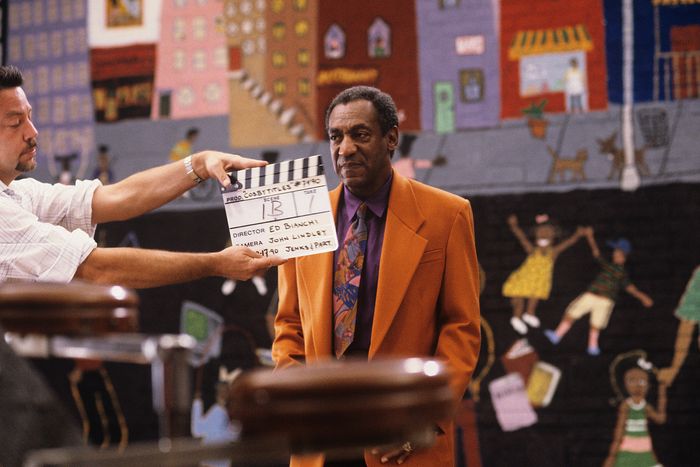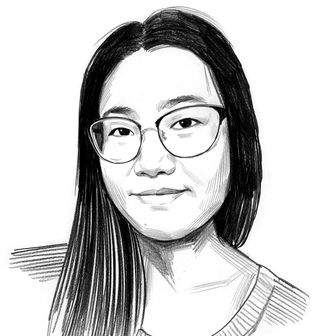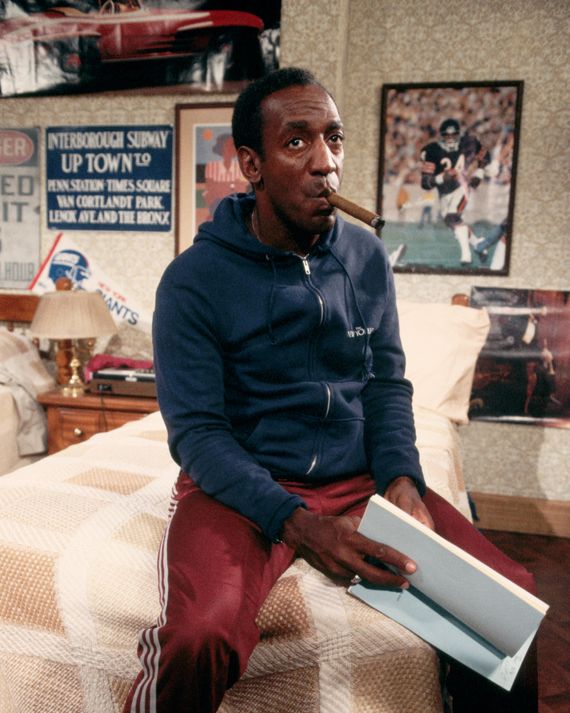
Bill Cosby cemented his nickname and reputation as “America’s Dad” with his role as Cliff Huxtable, the beloved father on NBC’s 1984–1992 hit series The Cosby Show. Today, however, the comedian is known for dozens of allegations of sexual assault against him (all of which he has continuously denied). Cosby served nearly three years in prison for sexual assault before being released in 2021; the conviction was overturned because a prosecutor had promised not to charge him.
W. Kamau Bell’s four-part Showtime docuseries, We Need to Talk About Cosby, tracks Cosby’s rise and fall from public grace. The third episode, out February 13, focuses on the success of The Cosby Show and includes allegations that Cosby behaved inappropriately on the very set where he built his reputation as a wholesome father. The show began filming in Brooklyn but eventually moved to a larger studio in Queens. By then, much of America was familiar with the Huxtables and their weekly antics. According to the documentary, the highest-rated episode of The Cosby Show had 65 million viewers, about a quarter of the U.S. population at the time.
Some women have alleged that Cosby made unwanted advances toward them on set. Multiple people who worked on the show, both on and off camera, described the constant presence of young models in the show’s audience. Here, a list of people involved in the show — including Cosby himself — who have acknowledged the arrangement that regularly brought models to Cosby’s dressing room.
Steve Watkins
Watkins was a director’s assistant on The Cosby Show. In We Need to Talk About Cosby, he said that around 200 people would be in the stands for live show tapings. “But then you’d get to this one pocket where there’s about 20, 25 women dressed to the nines,” he said. “They’re all models, and they look it.” A modeling agency would bring them over to “talk to Mr. C,” according to Watkins. “His dressing room was always open,” he said. “Not then.”
Frank Scotti
Scotti worked as a facilities manager at NBC’s studio in Brooklyn and later became Cosby’s personal assistant. In 2014, Scotti told the New York Daily News that he was tasked with standing guard at the door when Cosby had models in his dressing room. Scotti claims the owner of a Manhattan agency, ostensibly a woman named Sue Charney, would deliver models as young as 16 to the set. He said that Cosby would pick one, saying he wanted to interview her for a part in the show. “The owner just walked right out,” Scotti said. He claimed she “knew exactly what was going to go on. Then Cosby would tell me, ‘Stand outside the door and don’t let anyone in.’”
Scotti said he came forward because he “felt sorry for the women” making allegations against Cosby. During a Today interview, Cosby’s former right-hand man maintained that he didn’t know what happened in the dressing room but said he felt “dirty” and “like a pimp.”
Michelle Hurd
In 2014, actress Hurd wrote in a since-deleted Facebook post that Cosby was “VERY inappropriate” with her when she did stand-in work on The Cosby Show. “It started innocently, lunch in his dressing room, daily, then onto weird acting exercises [where] he would move his hands up and down my body,” she alleged. Hurd said that she started to “take notice” after she refused an invitation to Cosby’s house. She began talking to another stand-in actress on the set who claimed that Cosby was “doing the same thing to her, almost by the numbers.”
Eden Tirl
In We Need to Talk About Cosby, Tirl said that her modeling and acting agent introduced her to Cosby in 1989 after bringing her to set to watch a taping of The Cosby Show. She was later informed that she had been given a role as a police officer on the show. She said she felt uncomfortable when, despite only having around three lines, she was given her own dressing room. (Joseph C. Phillips, who had a recurring role, said he never had a dressing room of his own, and once had to share a storage closet with a co-star.)
In the middle of rehearsal on her first day, Tirl said Frank Scotti walked up to her and told her Cosby wanted her to have lunch in his dressing room. She said she was “led off the set” to Cosby’s dressing room, where she ate alone. When Scotti came up to her again the next day, Tirl said she refused to leave. Allegedly, two people dismissed her concerns, telling her, “Just go. This happens all the time, just go.”
According to Tirl, Cosby did not appear in his dressing room until the third day that she was summoned. Tirl alleged that he came in, closed the door, and locked it. “And he just said really pointedly, Eden, you know that you could have anything you wanted, right? You do understand who I am,” she said. Tirl said she rejected the comedian, telling him she associated him with Fat Albert and the Cosby Kids and Jell-O Pudding Pops. According to Tirl, Cosby’s mood soured and he said, “Don’t say that to me. They all say that to me.”
He allegedly then had her perform an acting exercise where he mirrored her movements from behind, which she said felt “very oppressive” and “sexual.” Tirl alleged that Cosby wrapped her in his arms and told her they had just “made love,” then told her she could leave. Tirl said she believes she was not the first person this happened to. “A lot of people [on set] knew,” she said. “Because you can’t do what he did unless you have other people supporting what you’re doing.”
Bill Cosby
In 2015, portions of a 1,000-page transcript of a deposition Cosby gave over four days in 2005 and 2006 for a sexual assault lawsuit became public. Cosby stated in the deposition that every week Sue Charney’s modeling agency would send five or six models to the studio where The Cosby Show was taped. Nicole Weisensee Egan published an excerpt of the transcript in her book Chasing Cosby: The Downfall of America’s Dad. In it, Cosby described the demographic of the models as “young women,” many of whom were from out of state and were “financially not doing well.” Cosby said he and Charney “agreed that it might be nice if they would come on the Thursday and see the show and have dinner between shows.”
According to Cosby, the models were provided with a “very, very good meal” in his dressing room that was likely “better than anything they’d had” in New York so far. He said that he felt he was sent models who hadn’t done as well as expected or hadn’t reached their potential. “And for the time and the work and some money that [Charney] put into them, this was sort of like a present,” he said. Cosby said that some young women came to these dinners more than once, and that he gave some of them jobs as extras on the show.
Alice Opell
By the time Cosby’s deposition was unsealed, Sue Charney had died. Her sister, Opell, acknowledged the arrangement in the Washington Post in 2015, but cast doubt on the extent of Charney’s involvement. “I don’t think she knew what was going on,” she said. “She did it as a courtesy he requested, that the models attend the taping.”
Helen Gumpel
Gumpel (née Selby) appeared in a guest role as a member of Clair Huxtable’s book club on The Cosby Show in 1987. The former fashion model and actress held a news conference in 2015 and came forward with allegations against Cosby.
Gumpel stated that after her guest spot, her agent received a call that Cosby wanted to meet her for what she thought was an audition for another part. She alleged that after Cosby hugged and kissed her in front of studio onlookers, she was sent to his dressing room. According to Gumpel, the comedian opened the door in a “loosely tied robe” and had her sit on the couch. He handed her a drink and put “his crotch area” in her face, she alleged. Gumpel said that Cosby got physically angry when she refused his advances and kept pressing the drink toward her. She claimed he eventually walked to the door and told her to leave.
Kaya Thompson
Jennifer “Kaya” Thompson told People she visited a modeling agency in New York City at 17 in 1988 — this would have been halfway through The Cosby Show’s run, at the height of the comedian’s fame. According to Thompson, she was sent to Queens right away to meet Cosby on the set of The Cosby Show. She told other outlets that this happened within an hour of her visit to the modeling agency. In 2014, Thompson accused Cosby of an unwanted sexual encounter at his home in the late ’80s.
Lili Bernard
Bernard, who has accused Cosby of sexual assault, guest-starred as one of Cliff Huxtable’s pregnant clients on the last season of The Cosby Show in 1992. She previously played a part with no lines in a 1988 episode. Bernard noted the constant presence of models on set during her interview in We Need to Talk About Cosby. “There was always a long line of beautiful women, all different shades … I mean, the whole gamut, the whole rainbow of the human race,” she said. “Yeah, they were lined up outside of his dressing room, poor things, going in and out.”
Joseph C. Phillips
Phillips played Martin Kendall on three seasons of The Cosby Show. In 2015, Phillips published a since-deleted blog post titled “Of Course Bill Cosby Is Guilty!” In it, he wrote that there was a seemingly “unending parade of pretty young women that streamed through the studio. In fact, that is what some of us called it — the parade. Light skinned. ‘Good’ hair. One prettier than the next.”
In We Need to Talk About Cosby, Phillips stated that models would sit in a row in the stands, and again described the models as “a parade” going to Cosby’s dressing room. “I don’t know what went on, and then they would go out. It was just kind of like the air,” he said with a laugh. “You know, it was there, and everybody knew it.”



